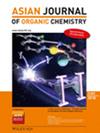Synthesis and Photophysical Properties of Conjugated Fluorophores with N‐Heteroaromatic Rings
IF 2.8
4区 化学
Q1 CHEMISTRY, ORGANIC
引用次数: 0
Abstract
Fluorescent molecules are vital parts of modern chemistry and find widespread use in our daily lives, being potent tools for quantitatively and qualitatively determining analytes in many habitats, including living systems. Their exceptional properties allow us to visualize and understand complex biological processes, even beyond intracellular levels, advancing our knowledge of life; they also play a focal role in materials science and the environment. All these facts highlight these compounds′ impact in all sciences despite several restricted uses since many dyes have poor synthetic viability and biocompatibility with limited optical and electronic properties. These flaws could be solved by conjugating a representative fluorophore with an N‐heteroaromatic moiety, which has proven helpful in this target. Thus, this review aims to analyze advances from the years 2019 to 2023 in syntheses and photophysical properties of N‐heteroaromatic compounds conjugated with (i) triphenylamine (TPA), (ii) coumarin (CM), (iii) boron complexes (BC), or (iv) aromatic hydrocarbons (AHs).
含n -杂芳环共轭荧光团的合成及其光物理性质
荧光分子是现代化学的重要组成部分,在我们的日常生活中得到广泛应用,是在许多栖息地(包括生命系统)中定量和定性测定分析物的有力工具。它们的特殊特性使我们能够可视化和理解复杂的生物过程,甚至超越细胞内水平,提高我们对生命的认识;它们在材料科学和环境中也发挥着重要作用。所有这些事实都突出了这些化合物在所有科学领域的影响,尽管有一些限制用途,因为许多染料的合成活力和生物相容性较差,光学和电子性能有限。这些缺陷可以通过将具有代表性的荧光团与n -杂芳基团偶联来解决,这已被证明对该目标有帮助。因此,本文旨在分析2019年至2023年n -杂芳香化合物与(i)三苯胺(TPA), (ii)香豆素(CM), (iii)硼配合物(BC)或(iv)芳烃(AHs)偶联的合成和光物理性质的进展。
本文章由计算机程序翻译,如有差异,请以英文原文为准。
求助全文
约1分钟内获得全文
求助全文
来源期刊

Asian Journal of Organic Chemistry
CHEMISTRY, ORGANIC-
CiteScore
4.70
自引率
3.70%
发文量
372
期刊介绍:
Organic chemistry is the fundamental science that stands at the heart of chemistry, biology, and materials science. Research in these areas is vigorous and truly international, with three major regions making almost equal contributions: America, Europe and Asia. Asia now has its own top international organic chemistry journal—the Asian Journal of Organic Chemistry (AsianJOC)
The AsianJOC is designed to be a top-ranked international research journal and publishes primary research as well as critical secondary information from authors across the world. The journal covers organic chemistry in its entirety. Authors and readers come from academia, the chemical industry, and government laboratories.
 求助内容:
求助内容: 应助结果提醒方式:
应助结果提醒方式:


